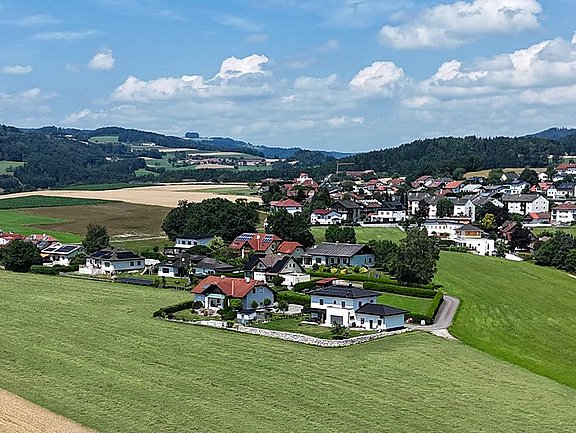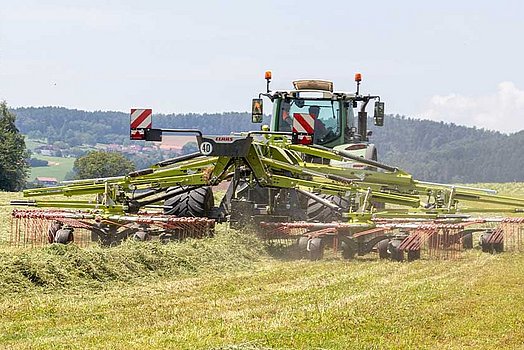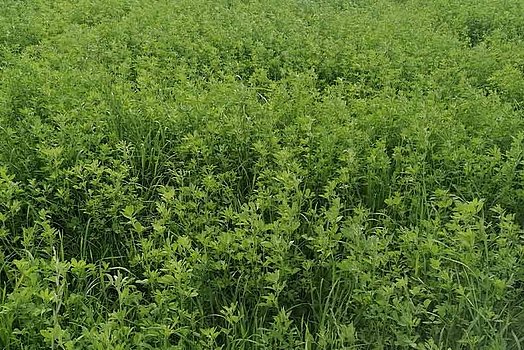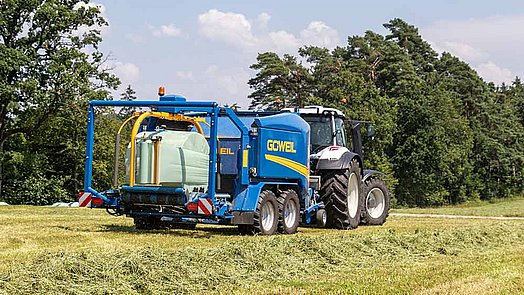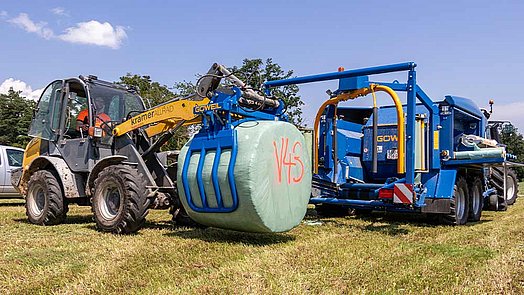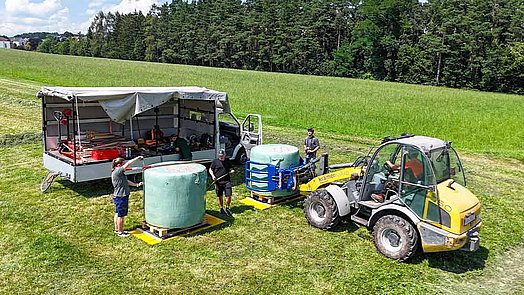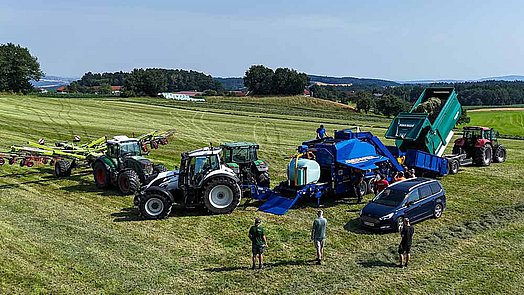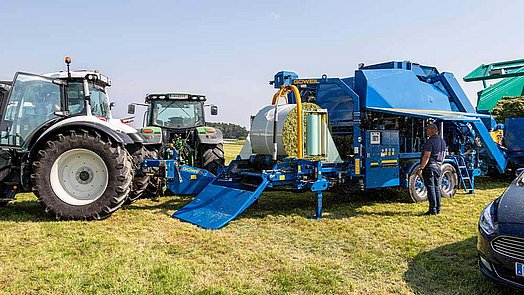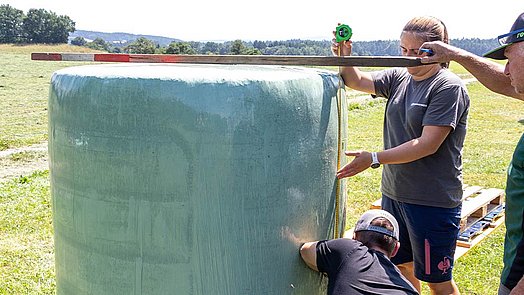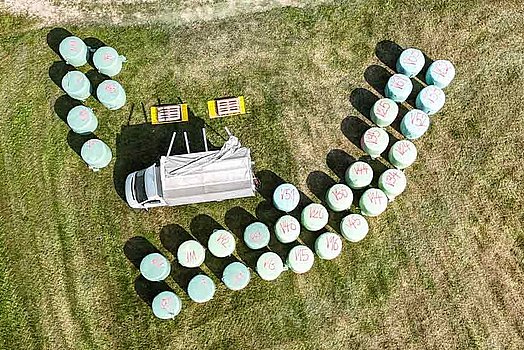GÖWEIL quality confirmed
Technology that delivers what it promises
In the summer of 2024, the team from Josephinum Research Wieselburg intensively tested both the G-1 F125 Kombi and the VARIO-Master V140, putting them through a series of demanding trials with scientific precision.
The outcome? Expectations were not only met, but vastly exceeded!

Josephinum Research Wieselburg:
Josephinum Research in Wieselburg is a central research facility for agricultural technology. The facility focuses on precision farming, digitalization, and modern measuring technology. As part of the HBLFA Francisco Josephinum, it combines research with practice for the further development of agriculture.
Preparation and harvesting conditions:
Harvest preparation begins with mowing on July 8, supported by a mower conditioner to optimize the drying process. This is followed the next morning (July 9) by tedding. Swathing is performed with a four-rotor swather, resulting in a swath width of 130 cm. The average swath mass is 2.1 kg DM/m.
Baling test: Execution and material properties
The alfalfa grass with a high alfalfa content (third growth) is baled on the afternoon of July 9. The material has an average DM content of 48.6% and a fiber content of 32.7% per kg DM – values that are typical for bulky baled material. Depending on the cutting knife set used:
- Half cutting knife set: 70 mm cutting knife spacing
- Full cutting knife set: 35 mm cutting knife spacing
Four layers of net or wide film (0.016 mm) and six layers of wrapping film (0.025 mm) are used for bale binding.
Test variants G-1 F125 Kombi
Four different variants are compared in the test:
- V1: Half cutting knife set, net binding, 7 km/h
- V2: Full cutting knife set, net binding, 7 km/h
- V3: Full cutting knife set, wide film, 7 km/h
- V4: Full cutting knife set, wide film, 10 km/h
G-1 F125 Kombi – the results at a glance
Bale density and feed quality:
Despite the high dry matter and fiber content, bale densities of 177 to 185 kg DM/m³ are achieved – an increase of up to 13% compared to the Austrian average (164 kg DM/m³). This high degree of compression ensures optimum ensiling conditions, keeps nutrient losses to a minimum, and minimizes incorrect fermentation. The butyric acid content of 1.8 g/kg DM is well below the guideline value of < 3 g/kg DM specified by the Austrian working group for the grassland and livestock industry (ÖAG), a clear indication of excellent silage quality.
Processing capacity:
Depending on the variant, the measured mass flow ranges from 13 t DM/h to 20.5 t DM/h. The bale density can even be maintained at an increased speed of 10 km/h. A high mass flow forms the basis for high area performance. Under favorable conditions, a high bale density can even be achieved with a full cutting knife set – with a collection capacity of up to 14 t DM/h. The potential area performance therefore stands at almost 5 ha/h (at 3 t DM/ha) – a value that exceeds high-performance short cutting silage wagons, and that even well-organized chopper chains have difficulty achieving (at least 14 t rolling weight is required here).
Drive and energy requirements
The average power requirement at the PTO shaft is between 29 and 48 kW, with maximum values of 66 to 102 kW. The idle power is just 2.4 kW, well below variable balers under similar conditions (Ø 5.64 kW); this indicates a particularly energy-efficient drive.
The specific energy consumption during the baling process is very low at 2.21 to 2.77 kWh/t DM. Variant 4 (10 km/h and 30 cutting knives) is extremely efficient at 2.33 kWh/t DM despite a full cutting knife set and a high mass flow. In a similar comparison with variable round balers, the value is higher at ⌀ 2.65 kWh/t DM
(kWh/t DM = energy required to compress one ton of dry matter).
Fewer bales for the same amount of feed means savings on film, net, working time, fuel, and storage space. A high bale density therefore not only increases profitability, but also protects the environment.
VARIO-Master V140 compared – top quality chopped material
Test framework
In parallel to the G-1 test, two further variants are tested with the VARIO-Master – based on identical alfalfa grass and the same harvesting conditions:
V5: Chopped material (4 mm), wide film
V6: Chopped material (4 mm), net binding
Bale density and feed quality
Both variants achieve exceptionally high compression:
V5 (wide film): > 264 kg DM/m³
V6 (net binding): ~ 259 kg DM/m³
Despite the bulky starting material with a high dry matter and fiber content, a compression level well above the average attained by bunker silos (197 kg DM/m³) is achieved. Although the theoretical cutting length is 4 mm, the cutting length analysis shows that only 45% of the particles are less than 10 mm long. This is an indication that the actual cutting length deviates from the theoretical length, although this is entirely normal under real-life conditions.
The extremely low butyric acid content of only 0.1 g/kg DM (in some cases even below the detection limit) is evidence of excellent fermentationconditions. As such, the targeted optimum silage quality is achieved with maximum suitability for storage.
Further advantages of the chopped material
The high bale density not only saves resources in the form of film, net, working time, and storage space, it also enhances feeding process efficiency:
Improved bale break-up
Higher feed pick-up and digestibility
Direct increase in profitability across the entire production chain
Conclusion
The results of the combined practical test show that
both the G-1 F125 Kombi and the VARIO-Master V140 deliver first-class results when it comes to bale density, feed quality, and energy efficiency in a range of different application scenarios. The VARIO-Master fares particularly well when processing chopped material with compression results that far exceed even bunker silage values.
GÖWEIL technology impresses – with performance, efficiency, and economy.
© Josephinum Research Wieselburg, 2024: Untersuchungen an Press-Wickel-Kombinationen [Tests on baler-wrapper combinations]
© Galler J., 2011: Silagebereitung von A bis Z Grundlagen [Basics of silage preparation from A to Z]
© Resch R., 2025: Gras- und Maissilagen am Qualitätsprüfstand [Grass and corn silage on the quality test bench]
© Handler F., Nadlinger M., Rechberger C., Pöllinger A., Paar J., 2021: Rundballenpressen im Vergleich [A comparison of round balers], Schweizer Landtechnik, issue 4/2021
